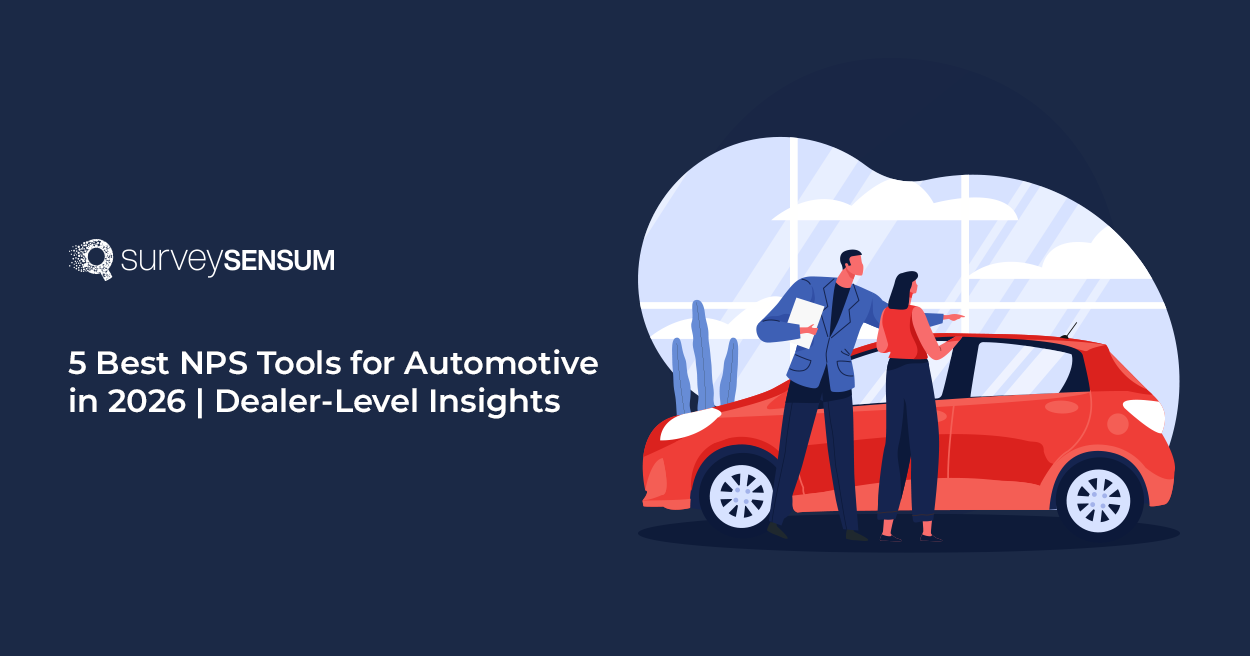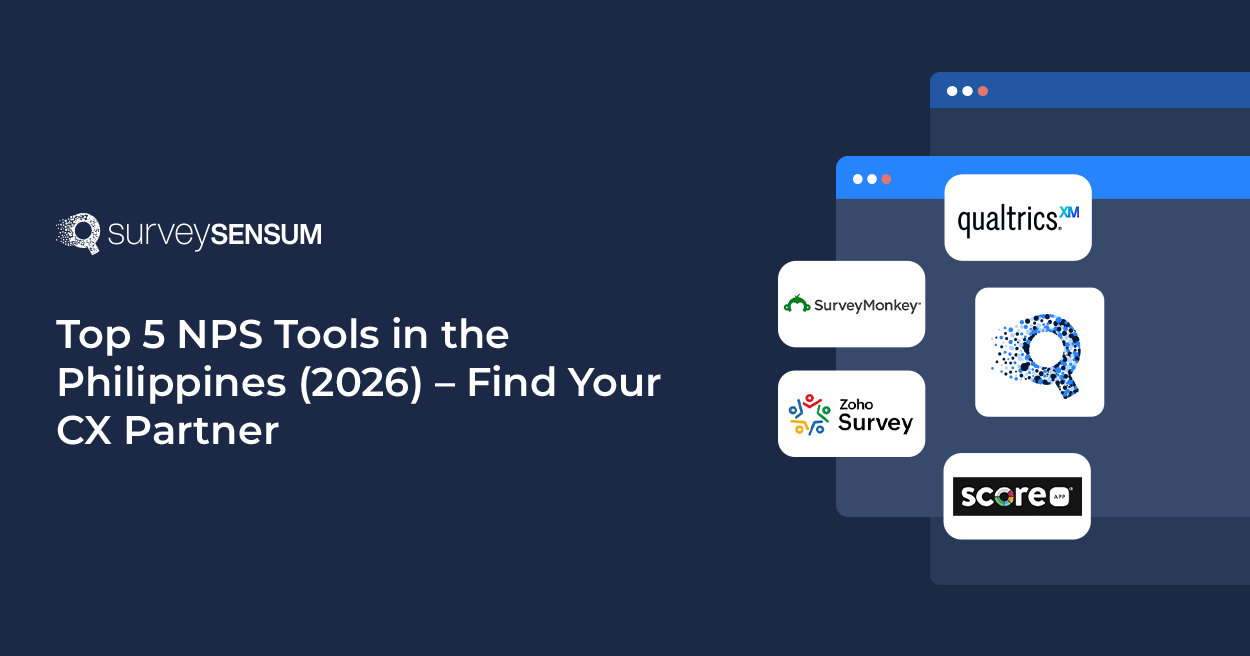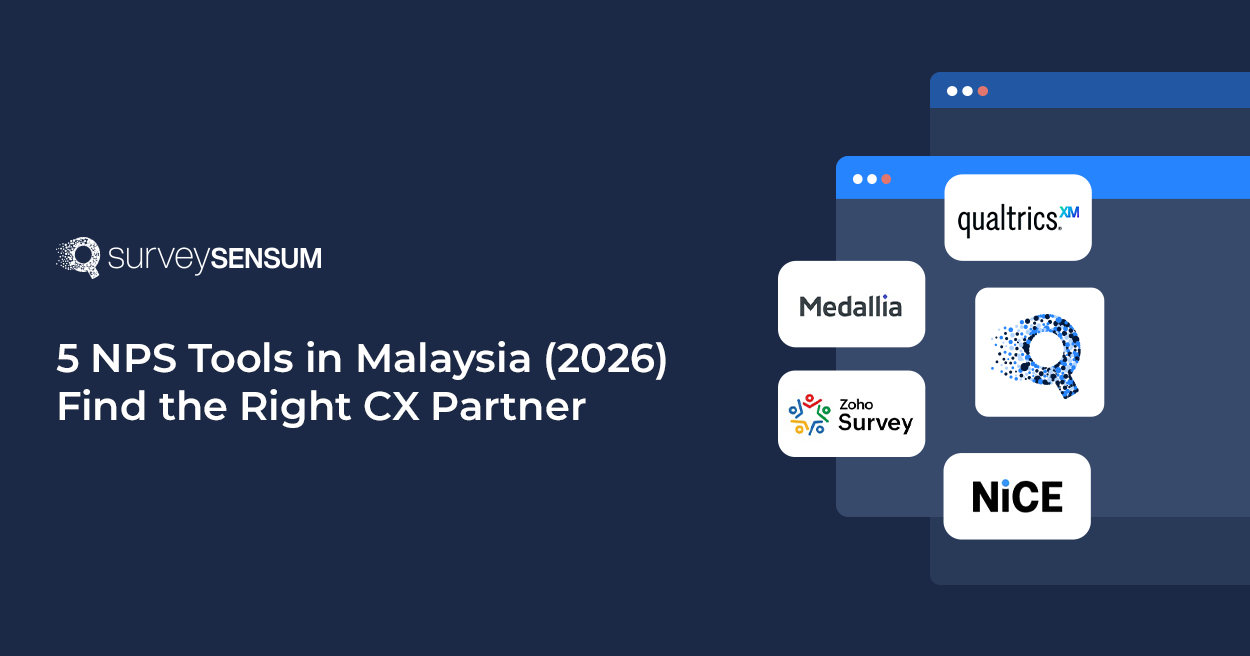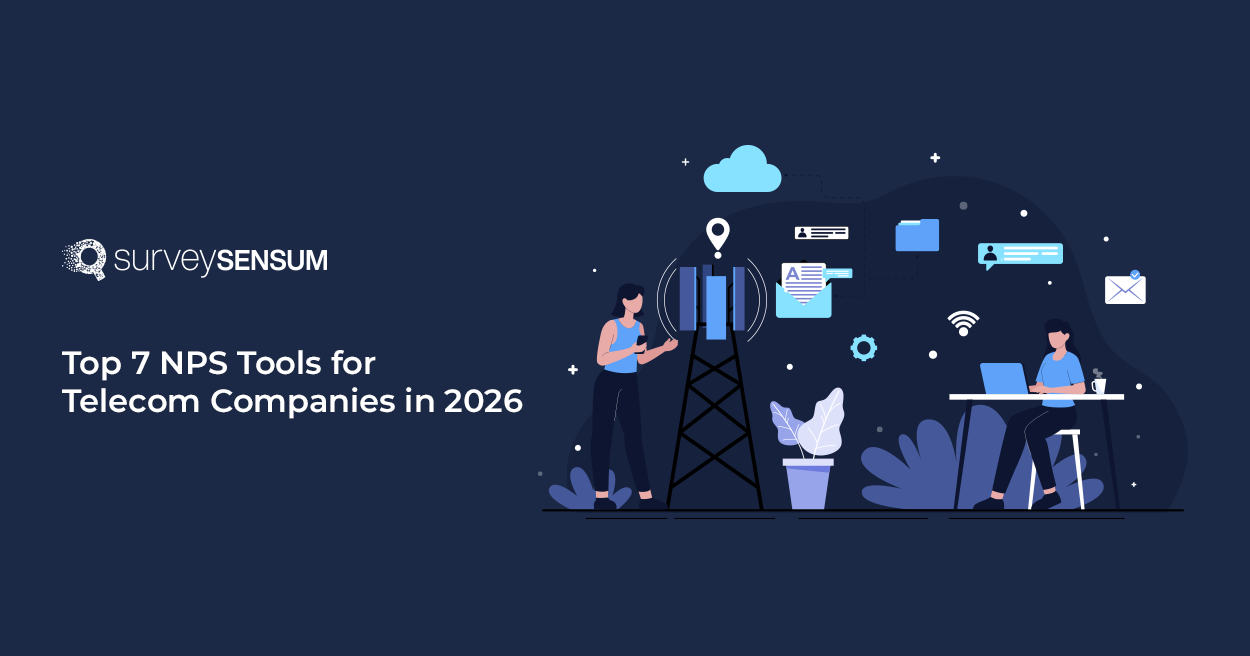

Top 5 NPS Tools for Automotive Brands in 2026 – See What’s Really Happening at Every Workshop

Let’s be honest – running NPS in automotive is a different beast altogether.
If you’ve ever looked at a “national CSI score” and still had no clue which workshop or which region is dragging it down, you know what I’m talking about.
You don’t need another survey vendor.
You need visibility.
Visibility into every dealer, workshop, region, and service center.
Because your real problem isn’t “measuring satisfaction.” It’s finding where it’s breaking.
Sound familiar? Then this list is for you.
TL;DR: The Best NPS Tools for Automotive in 2026
Running NPS in automotive isn’t about collecting scores – it’s about finding which dealer or workshop is causing them to drop.
If you’re still using phone-based vendors or Excel-based reports, you’re already behind.
Here’s the quick breakdown
1. SurveySensum – Best for OEMs, Distributors & Dealer Networks
Designed specifically for automotive with dealer-level dashboards, WhatsApp surveys, real-time ticketing, and AI-powered insights through the SensAI Co-Pilot.
2. Qualtrics – Best for Global OEMs with In-House CX Teams
Powerful enterprise platform offering deep customization, benchmarking, and predictive analytics but complex to set up and maintain.
3. InMoment – Best for Large OEMs with Mature CX Programs
Great for predictive insights and journey analytics across multiple countries, though implementation can be slow and resource-heavy.
4. Medallia – Best for Enterprise Automotive CX Frameworks
Known for its CRM/DMS integrations and enterprise-grade AI analytics, ideal for large-scale CX operations, but less agile.
5. Survicate – Best for Mobility & EV Brands
Lightweight, flexible, and perfect for digital-first automotive startups or app-based service models – quick setup, simple interface.
✅ If your NPS program can’t show which dealer dropped the score this week – it’s time to switch.
Book a 15-minute demo with SurveySensum and see dealer-level dashboards in action
The Real Problem: You’re Blind Below the Surface
Here’s what every automotive CX leader I talk to says:
“Our overall NPS looks fine… but I can’t see which dealer messed up this week.”
That’s the core issue.
You’ve got:
- 100+ dealers, 300+ workshops, 5+ regions.
- Multiple vendors sending Excel sheets.
- Feedback that’s two weeks late.
- No clear way to hold anyone accountable.
And that’s before you even touch the CATI calls (where half the customers hang up or are told what to answer).
So, let’s talk about the tools that actually solve these issues – not just collect another round of scores.
Comparison Table: Best NPS Tools for Automotive in 2026
|
Tool |
Best For |
Key Features |
AI Capabilities |
Implementation Speed |
Support Quality |
Ideal Automotive Use Case |
|
Automotive OEMs, Dealers & Distributors |
✅ Dealer, workshop, and region dashboards ✅WhatsApp + Email surveys ✅ Real-time ticketing & instant alerts ✅ Text analytics for verbatim feedback ✅ CSI, SSI & NPS in one platform |
✅ SensAI Co-Pilot (AI root-cause analysis) ✅ Theme & sentiment detection ✅ AI survey builder for CSI/NPS |
Fast (2–3 weeks) |
24/7 human-led CX support |
Multi-dealer, multi-region programs needing visibility & automation |
|
|
Qualtrics |
Global automotive enterprises |
✅ Multi-country programs ✅Advanced survey logic ✅Predictive analytics |
✅ Predictive AI, custom models |
Moderate (4–8 weeks) |
Enterprise-grade managed support |
Large OEMs with mature CX departments |
|
InMoment |
OEMs with large CX teams |
✅ Journey analytics ✅Predictive modeling |
✅ Advanced AI engine |
Moderate (4–8 weeks) |
Managed enterprise support |
Global OEMs seeking predictive CX trends |
|
Medallia |
Multinational automotive brands |
✅ CRM + DMS integration ✅ Closed-loop automation ✅ Multi-language dashboards |
✅ Speech, text & emotion AI |
Slow (6–10 weeks) |
Premium enterprise support |
Global brands with complex ecosystems |
|
Survicate |
Digital-first automotive startups |
✅ Web, app, and email surveys ✅Lightweight deployment |
✅ Basic sentiment tagging |
Fast (1–2 weeks) |
Responsive email support |
Mobility, EV, and digital-first automotive players |
Detailed Breakdown: The Top 5 NPS Tools for Automotive Brands
1. SurveySensum – Built for Automotive CX, Not Just Surveys
Let’s start with the truth:
Most automotive NPS tools were built for SaaS or ecommerce. They’re great at analyzing online clicks – not customer frustration at a real-world workshop.
SurveySensum was built differently – with the automotive use case in mind.
If this sounds familiar…
- “I can’t see which dealer’s NPS dropped this week.”
- “Our CX team gets feedback a month later.”
- “We’re spending on phone surveys, but still don’t know what’s wrong.”
Then you’ll probably love what SurveySensum does.
Why Automotive Brands Choose It
- Dealer-level dashboards: View CSI, SSI, and NPS for every dealer, workshop, and region – instantly.
- Real-time ticketing: Every detractor triggers an alert to the right team (dealer, service head, regional manager).
- WhatsApp surveys: Replace expensive phone surveys – and boost response rates by 30-40%.
- AI text analysis: Automatically detect themes like service delay, rude staff, long waiting time, etc.
- SensAI Co-Pilot: Ask “Why are NPS scores lower in East Region?” and get instant answers from your data.
- End-to-end automation: CSI + SSI + NPS under one roof. No more fragmented vendors.
- World-class support: A CX team that’s as responsive as your best service advisor.
Real Automotive Results
- 35% higher response rate (via WhatsApp & Email)
80% survey cost reduction - 80 hours/week saved on reporting
“SurveySensum gives us real-time insights into all our sales (before and after). We loved its WhatsApp integration and alert automation.”
– Blandina Siregar, Head of Customer Relations, PT. Nissan Motor Distribution Indonesia
Mercedes-Benz (Daimler Indonesia)
- 30% boost in CSAT
- 60% cost savings
- Instant alerts for 27 dealers
“SurveySensum helped us identify every low-score respondent instantly and close loops in real time.”
– Ade Dwi Septiani Jusa, Daimler Commercial Vehicles Indonesia
Honda Motor (Astra Honda)
- 70% survey cost drop
- Real-time CSI data without manual effort
- 10 hours saved weekly
“WhatsApp surveys gave faster, more honest feedback. Text analytics helped us act instantly.”
– Adi Purwaputra, Astra Honda Motor
👉 Tired of waiting for monthly reports? Book a 15-min demo and see real-time dealer dashboards in action.
2. Qualtrics – The Enterprise Heavyweight
Qualtrics is big, powerful, and everywhere – but it’s also heavy, complex, and designed more for global programs than regional agility.
If you’re running multi-country automotive CX programs with your own internal analysts, Qualtrics delivers advanced logic and predictive analytics.
Why Automakers Use It
- Deep customization, benchmarking, and enterprise data models.
- Excellent if you’ve got internal data teams.
But here’s the catch:
- You’ll wait months for setup.
- Dealer-level dashboards? You’ll likely have to build those yourself.
- WhatsApp feedback? Not native.
Best for: Global OEMs with mature CX departments.
3. InMoment – Predictive, But Complex
If you’re running a global CX program with multiple data sources and want predictive analytics, InMoment is solid – but it’s not plug-and-play.
Why it works:
- Predictive satisfaction analytics across markets.
- Text and sentiment analysis with custom models.
Limitations:
- Long implementation cycles.
- Needs a big team to manage.
- Not ideal for region-level or dealer performance tracking.
Best for: Enterprise CX teams focused on forecasting, not daily action.
4. Medallia – The Legacy CX Powerhouse
Medallia is a trusted name in automotive – several OEMs use it for structured global programs. It integrates with CRMs, dealer systems, and even call-center feedback.
Why it’s good:
- Advanced speech and text analytics.
- Closed-loop workflows for large networks.
But…
- Heavy, slow, and pricey.
- Better suited for top-down CX strategy, not daily dealer operations.
Best for: Large OEMs managing global CX frameworks.
5. Survicate – Good for Digital Automotive Journeys
Survicate fits well for automotive startups or digital-first platforms – think EV brands or car financing apps.
Why it works:
- Web, app, and email survey triggers.
- Integrations with HubSpot, Intercom, etc.
Why it doesn’t:
- No regional dashboards or workshop-level insights.
- No WhatsApp or SMS channels.
Best for: Automotive tech or mobility brands with online CX focus.
So, Why Do Automotive NPS Programs Fail?
Let’s call it what it is – lack of visibility.
You’re running feedback programs blind.
- You see an overall CSI score, but not which dealer caused it.
- You get monthly reports, not real-time alerts.
You rely on call centers that miss half your customers. - You read “10/10” feedback that you know was influenced at the counter.
You don’t need another survey form.
You need clarity, accountability, and speed.
Final Thoughts
If you’re in automotive CX, your goal isn’t to collect feedback.
It’s to fix experiences before they go public.
That’s why the future of automotive CX belongs to platforms that give dealer-level visibility, AI insights, real-time alerts, and WhatsApp-scale response.
And right now, that’s SurveySensum.
Because in automotive –
The brand that listens fastest, wins first.
Start listening faster with SurveySensum.
Frequently Asked Questions on Top NPS Tools for Automotive
The best NPS software for automotive in 2026 is SurveySensum, designed for dealer and workshop-level insights, real-time ticketing, and AI-powered feedback analysis. It’s built specifically for automotive OEMs and dealer networks.
NPS helps automotive brands identify service quality gaps across workshops, dealers, and regions. It pinpoints where customer experience is breaking, helping reduce churn and increase brand loyalty.
Leading automakers now use WhatsApp surveys, email surveys, and QR code feedback at service centers instead of outdated phone-based systems for faster and more authentic responses.
SurveySensum is faster to deploy and more dealer-focused, while Qualtrics and Medallia are better for large enterprises needing complex integrations but take longer to implement.
















